It looks like you're using an Ad Blocker.
Please white-list or disable AboveTopSecret.com in your ad-blocking tool.
Thank you.
Some features of ATS will be disabled while you continue to use an ad-blocker.
share:
I have created a collection of searchable PDF files containing 8,759 pages of Canadian UFO documents.
With the permission of the Canadian government, this collection can now be downloaded from www.box.com/s/xgc5ye9dwyf93tu1zi0j (discussed in Section B of this thread).
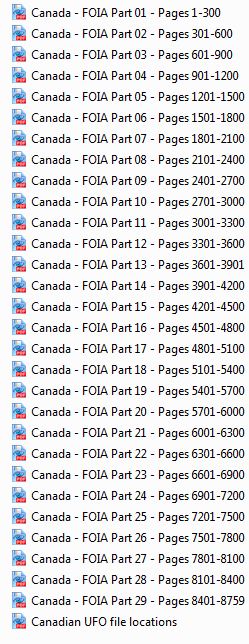
In other sections of this post I give some samples from this collection of PDF files, including material relating to Project Magnet (including Page 6780 below, which comments in relation to the Project Magnet file that “at no time should it be made available to the public”) and some other pages that caught my eye. I’ll also include updated sections on material I’ve previously posted about the Falcon Lake incident and the Shag Harbour incident.
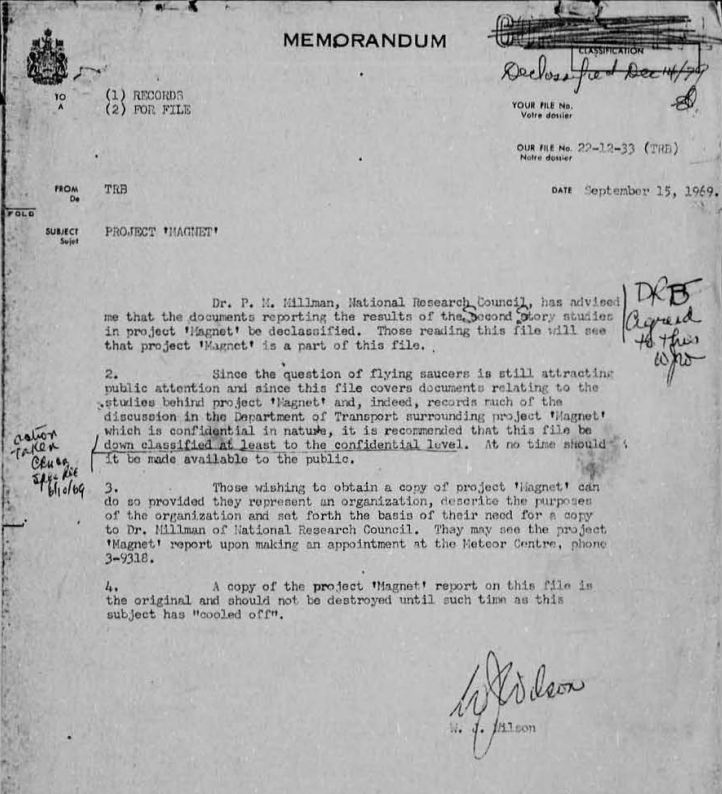
I think this PDF collection is much easier to download, and more user friendly, than the somewhat complicated method I posted last year to download individual images of these documents from the relevant official Canadian website.
Please note: When giving its permission on behalf of the Government of Canada, the Copyright Services branch of Library and Archives Canada requested that I acknowledge the source of these documents as follows:
This post is in several sections, namely:
SECTION A : THIS BRIEF INTRODUCTION
SECTION B : THE PDF ARCHIVE
SECTION C : WILBERT SMITH, PROJECT MAGNET AND SECOND STOREY
SECTION D : OTHER SELECTED PAGES
SECTION E : BURNT BY A UFO? THE FALCON LAKE INCIDENT
SECTION F : UFO CRASH? THE SHAG HARBOUR INCIDENT
SECTION G : REFERENCES
SECTION H : POSTSCRIPT
With the permission of the Canadian government, this collection can now be downloaded from www.box.com/s/xgc5ye9dwyf93tu1zi0j (discussed in Section B of this thread).

In other sections of this post I give some samples from this collection of PDF files, including material relating to Project Magnet (including Page 6780 below, which comments in relation to the Project Magnet file that “at no time should it be made available to the public”) and some other pages that caught my eye. I’ll also include updated sections on material I’ve previously posted about the Falcon Lake incident and the Shag Harbour incident.

I think this PDF collection is much easier to download, and more user friendly, than the somewhat complicated method I posted last year to download individual images of these documents from the relevant official Canadian website.
Please note: When giving its permission on behalf of the Government of Canada, the Copyright Services branch of Library and Archives Canada requested that I acknowledge the source of these documents as follows:
Description: Canada’s UFOs: The Search for the Unknown
© Government of Canada. Reproduced with the permission of the Minister of Public Works and Government Services Canada (2012).
This post is in several sections, namely:
SECTION A : THIS BRIEF INTRODUCTION
SECTION B : THE PDF ARCHIVE
SECTION C : WILBERT SMITH, PROJECT MAGNET AND SECOND STOREY
SECTION D : OTHER SELECTED PAGES
SECTION E : BURNT BY A UFO? THE FALCON LAKE INCIDENT
SECTION F : UFO CRASH? THE SHAG HARBOUR INCIDENT
SECTION G : REFERENCES
SECTION H : POSTSCRIPT
edit on 20-11-2012 by IsaacKoi because: (no
reason given)
edit on 20-11-2012 by IsaacKoi because: (no reason given)
edit on 20-11-2012 by IsaacKoi because: (no
reason given)
SECTION B : THE PDF ARCHIVE
Last year I wrote a thread here on ATS entitled Canadian disclosure: “UFO Found” and other documents/photos. That thread referred to the UFO documents which had previously been released in Canada and made available online (but which had – prior to that thread - not been discussed very much online).
In that discussion, I speculated that one of the possible reasons for the Canadian documents generating relatively little discussion (apart from the fact that ufology is dominated by authors and researchers from the USA) is that the relevant Canadian government website does not have an option for downloading the entirety of the UFO files. I therefore outlined one method of downloading the documents from the relevant official Canadian website. That thread prompted some very helpful input from several members of ATS (particularly freelance_zenarchist and ArMaP) to identify and fill in some gaps in the blocks of relevant documents I had identified.
However, the downloading method I posted last year required users to put in a reasonable amount of effort.
I’m therefore pleased that I can now post (with the permission of the Canadian government) a link to a set of searchable PDF files that I’ve created of the UFO documents released in Canada: www.box.com/s/xgc5ye9dwyf93tu1zi0j.
You can select individual sets of files or download the entire collection by clicking on the “Download Folder” button at the top right of that webpage:
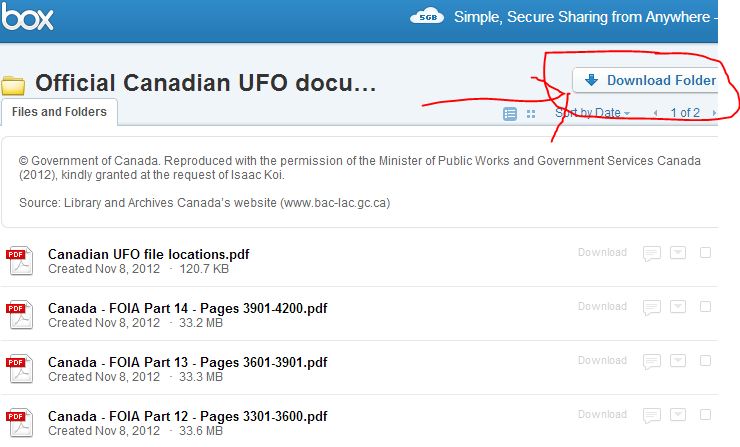
Of course, as with all uses of Optical Character Recognition software to convert images into searchable PDF files, the results are only as good as the source material. Many of the images released by the Canadian government are imperfect (and, in some cases, completely illegible). Search results with these PDF documents are therefore imperfect – but I find these results considerably better than not having any search results at all! I would say that the search results are worse than with searches of the UFO documents released by the British Ministry of Defence or the redacted copies of Project Blue Book files released in the USA, but better than the results of searching the unredacted copies of Project Blue Book files.
I think that the ability to store these PDFs on your own hard-drive limits reliance on slow internet access to online documents. Also, being able to search these PDFs for keywords complements the various search options (e.g. by date of a sighting) on the relevant official Canadian website. It’s worth having a glance at the search options on the official Canadian website and thinking about the best way(s) to perform any particular searches that you have in mind.
If you see something you consider interesting in the PDF files, you may well want to be able to give a link to the relevant document on the relevant official Canadian website. To make it easier to find a relevant URL for a specific page within the PDF files, I’ve created a list of image numbers on the Canadian website for each of the 8,759 pages within the PDF files. I’ve uploaded that list of file locations as part of the collection of PDF documents. You can use that document to look up the relevant page number in the PDF documents and get the image number on the official website (e.g. page 6780 in the PDF documents has an official image number of e002997366).
Basically:
(a) The left hand column in that document lists each page number within my PDF archive of Canadian UFO documents
(b) The right hand column gives the corresponding long “e” number, which forms part of URL for that page on the official Canadian website.

For example, if you want to find an official copy of page number 5063 in my PDF archive then just scroll down to the line beginning “5063” (or do
a search for “5063.” – including the full stop after the number) and you’ll find the corresponding “e” number (“e002749627”)
indicating that the relevant page is at:
data2.collectionscanada.gc.ca...
Unfortunately, the precise URL for a document on the Canadian archive website varies slightly depending on which block of URLs the long“e” number falls within. All of the URL begin with “data2.collectionscanada.gc.ca” but the part of the URL thereafter varies, e.g. /e/e110/e002744278.jpg (making the URL data2.collectionscanada.gc.ca..." target="_blank" class="postlink">data2.collectionscanada.gc.ca/e/e110/e002744278.jpg). The URLs are in different blocks containing different short “e” number (e.g. “/e/e110/”, or “/e/e110/”, or “/e/e120/”), depending on the long “e” number. The relevant blocks are:
(a) from /e/e110/e002744278.jpg to /e/e110/e002749999.jpg
(b) from /e/e111/e002750000.jpg to /e/e111/e002750209.jpg osted by freelance_zenarchist
(c) from /e/e111/e002750306.jpg to /e/e111/e002751233.jpg
(d) from /e112/e002799600.jpg to /e112/e002799811.jpg osted by freelance_zenarchist
(e) from /e/e120/e002996914.jpg to /e/e120/e002996931.jpg
(f) from /e/e120/e002997366.jpg to /e/e120/e002997414.jpg osted by ArMaP
(g) from /e/e120/e002997420.jpg to /e/e120/e002997675.jpg osted by freelance_zenarchist
(h) from /e/e120/e002999664.jpg to /e/e120/e002999999.jpg
(i) from /e/e121/e003000000.jpg to /e/e121/e003001631.jpg
Thus, for example, page 6780 in the PDF documents has an official image number of e002997366 which is in a block beginning with a short e number of e120, so the URL is: data2.collectionscanada.gc.ca/e/e120/e002997366.jpg
To try to make this easier to follow, in addition to posting some new sample pages (in Sections C and D) I’ve update some material I’ve previously posted (in Sections E and F) giving the page numbers in the PDFs and also the relevant URL.
This may sound a little complicated, but if you look at one or two examples you should get the hang of it within a minute or so. If anyone has any problems, just post in this thread and I’ll do my best to help (or to further simplify the process).
Despite the helpful assistance last year from freelance_zenarchist, ArMaP and others last year, some small gaps may remain in this collection of the UFO documents available on the relevant official Canadian website. As I mentioned in my previous thread about the Canadian documents available online, some of the (limited) coverage of the web access to the relevant documents had referred to “9,500 files” (while the PDF files I’ve made available contain 8,759 pages):
www.prweb.com...
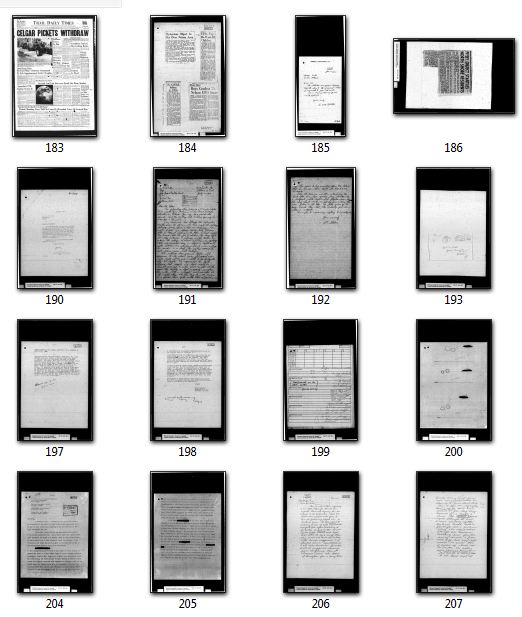
Unfortunately, the precise URL for a document on the Canadian archive website varies slightly depending on which block of URLs the long“e” number falls within. All of the URL begin with “data2.collectionscanada.gc.ca” but the part of the URL thereafter varies, e.g. /e/e110/e002744278.jpg (making the URL data2.collectionscanada.gc.ca..." target="_blank" class="postlink">data2.collectionscanada.gc.ca/e/e110/e002744278.jpg). The URLs are in different blocks containing different short “e” number (e.g. “/e/e110/”, or “/e/e110/”, or “/e/e120/”), depending on the long “e” number. The relevant blocks are:
(a) from /e/e110/e002744278.jpg to /e/e110/e002749999.jpg
(b) from /e/e111/e002750000.jpg to /e/e111/e002750209.jpg osted by freelance_zenarchist
(c) from /e/e111/e002750306.jpg to /e/e111/e002751233.jpg
(d) from /e112/e002799600.jpg to /e112/e002799811.jpg osted by freelance_zenarchist
(e) from /e/e120/e002996914.jpg to /e/e120/e002996931.jpg
(f) from /e/e120/e002997366.jpg to /e/e120/e002997414.jpg osted by ArMaP
(g) from /e/e120/e002997420.jpg to /e/e120/e002997675.jpg osted by freelance_zenarchist
(h) from /e/e120/e002999664.jpg to /e/e120/e002999999.jpg
(i) from /e/e121/e003000000.jpg to /e/e121/e003001631.jpg
Thus, for example, page 6780 in the PDF documents has an official image number of e002997366 which is in a block beginning with a short e number of e120, so the URL is: data2.collectionscanada.gc.ca/e/e120/e002997366.jpg
To try to make this easier to follow, in addition to posting some new sample pages (in Sections C and D) I’ve update some material I’ve previously posted (in Sections E and F) giving the page numbers in the PDFs and also the relevant URL.
This may sound a little complicated, but if you look at one or two examples you should get the hang of it within a minute or so. If anyone has any problems, just post in this thread and I’ll do my best to help (or to further simplify the process).
Despite the helpful assistance last year from freelance_zenarchist, ArMaP and others last year, some small gaps may remain in this collection of the UFO documents available on the relevant official Canadian website. As I mentioned in my previous thread about the Canadian documents available online, some of the (limited) coverage of the web access to the relevant documents had referred to “9,500 files” (while the PDF files I’ve made available contain 8,759 pages):
www.prweb.com...
The Toronto based independent news agency ZlandCommunications has learned that the Canadian government under the leadership of the Rt. Hon. Prime Minister Stephen Harper has provided open web access to approximately 9,500 UFO files at its archive web site, Library and Archives Canada.

SECTION C : WILBERT SMITH, PROJECT MAGNET AND SECOND STOREY

To illustrate the PDF collection which is now available, I’ll post a few documents below relating to Wilbert Smith and his work. Wilbert Smith has been referred to as “the most famous Canadian ufologist of all time” (Clark, 1998).
Those not familiar with Wilbert Smith may be interested with this recording made by Wilbert Smith on 11th November 1957:
A brief summary of government UFO documents relating to Wilbert Smith, Project Magnet and Second Storey can be found on the website of the Library and Archives Canada, at:
www.collectionscanada.gc.ca...
That summary begins as follows:
The PDF files include a copy of the Project Magnet report written by Wilbert Smith, including:
The first page of the Project Magnet report at page 6781 of the PDF collection (i.e. Part 23, page 181 of 300):
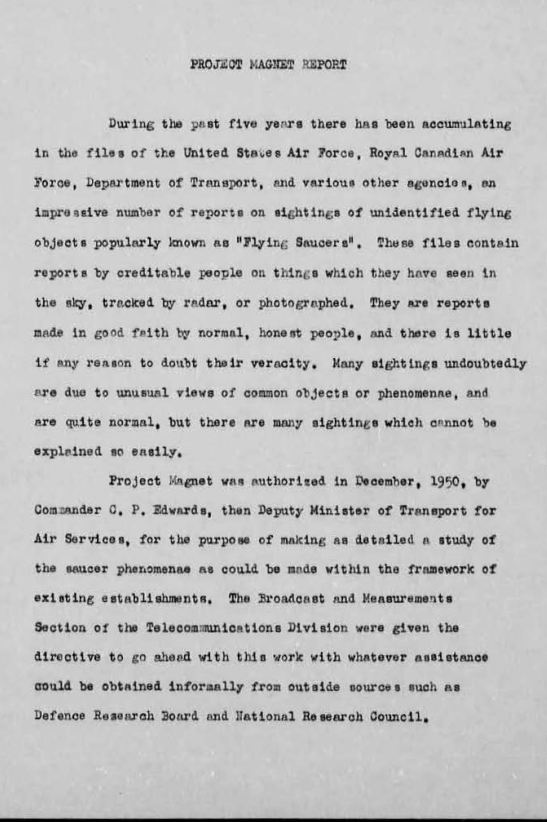
The final page of the Project Magnet report at page 6792 of the PDF collection (i.e. Part 23, page 192 of 300), including the conclusion that
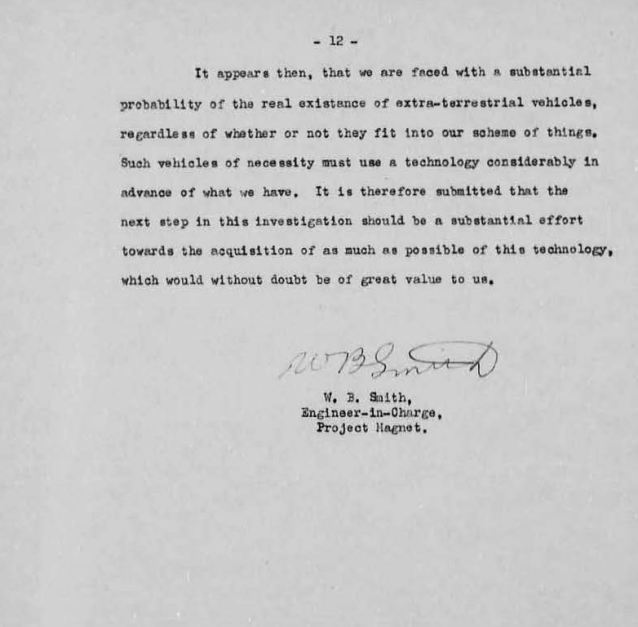

To illustrate the PDF collection which is now available, I’ll post a few documents below relating to Wilbert Smith and his work. Wilbert Smith has been referred to as “the most famous Canadian ufologist of all time” (Clark, 1998).
Those not familiar with Wilbert Smith may be interested with this recording made by Wilbert Smith on 11th November 1957:
A brief summary of government UFO documents relating to Wilbert Smith, Project Magnet and Second Storey can be found on the website of the Library and Archives Canada, at:
www.collectionscanada.gc.ca...
That summary begins as follows:
In 1950, a senior radio engineer from the Department of Transport, Wilbert B. Smith, made a request to his superiors to make use of a laboratory and the department's field facilities in a study of unidentified flying objects (UFOs) and the physical principles connected to them. Smith spearheaded Project Magnet with the purpose of studying, among other occurrences, magnetic phenomena, which he believed would open up a new and useful technology.
The goals of Project Magnet were fueled by the concepts of geomagnetism, and the belief that it may be possible to use and manipulate the Earth's magnetic field as a propulsion method for vehicles. Tests conducted by Smith were reported in November 1951 and they stated that sufficient energy was abstracted from the Earth's field to operate a voltmeter at approximately 50 milliwatts. Smith believed he was on the "track of something that may prove to be the introduction to a new technology." Smith believed that there was a correlation between his studies and investigations into UFOs: "...the existence of a different technology is borne out by the investigations which are being carried on at the present time in relation to flying saucers.... I feel that the correlation between our basic theory and the available information on saucers checks too closely to be mere coincidence" (Smith, Geo-Magnetics, Department of Transport, November 21, 1950).
It was believed by both Smith and other government departments involved, that there was much to learn from UFOs. Investigations into these sightings and interviews with the observers were the starting point for Project Magnet.
In connection with the establishment of Project Magnet, members of other government agencies formed a committee solely dedicated to "flying saucer" reports. This committee was sponsored by the Defense Research Board and called "Project Second Story." Its main purpose was to collect, catalogue and correlate data from UFO sighting reports. The committee created a questionnaire and interrogator's instruction guide. The reporting method used a system intended to minimize the 'personal equation'. In other words, a weighting factor was created to measure the probability of truth in each report. Smith explained that most UFO sightings fit into two general types: "those about which we know something, and those which we know very little."
The PDF files include a copy of the Project Magnet report written by Wilbert Smith, including:
The first page of the Project Magnet report at page 6781 of the PDF collection (i.e. Part 23, page 181 of 300):

The final page of the Project Magnet report at page 6792 of the PDF collection (i.e. Part 23, page 192 of 300), including the conclusion that
“… we are faced with a substantial probability of the real existence of extra-terrestrial vehicles”.

Wilbert Smith is – to put it mildly - a controversial figure, discussed in dozens of UFO books (see Section G below for relevant references).
For example, Timothy Good’s book “Above Top Secret” discusses Wilbert Smith at pages 178-184, 198-200 (in Chapter 8) of the Sidgwick & Jackson hardback edition (with the same page numbering in the Guild Publishing hardback edition and the Grafton paperback edition). That section can be found online on the Stealthskater website and states that Wilbert Smith was
Similarly, Michael Strainic wrote a biography for the NICAP web site (2002) at:
www.nicap.org...
A rather different impression about Wilbert Smith is given in the following comments from sceptics:
(b) A “Magonia” book review refers to Wilbert Smith as a:
pelicanist.blogspot.co.uk...
(b) Christopher D Allan, in a relatively detailed article on Wilbert Smith, refers to him as:
www.ufoupdateslist.com...
Particularly noteworthy for their detail (with supporting references/links) and their insight, are various articles by Paul Kimball (a Canadian film-maker and ufologist) relating to Wilbert Smith, particularly Paul Kimball’s articles on Wilbert Smith’s competence and credibility:
redstarfilms.blogspot.co.uk...
redstarfilms.blogspot.co.uk...
The latter article includes details of Wilbert Smith’s claims to have spent “many hours conversing with people from elsewhere”.
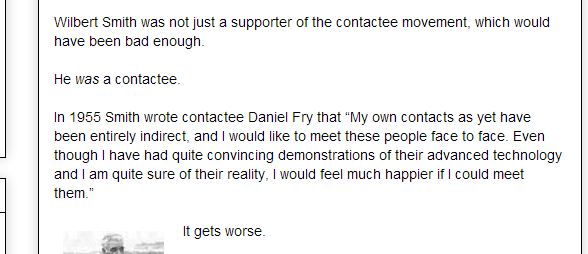
The issue of Wilbert Smith’s claims to have had contact with people from elsewhere is covered in quite a few of the discussions of Wilbert Smith’s work, e.g. in this discussion by Stuart Nixon in a NICAP publication (Nixon, 1973) - which makes it all the more surprising that this issue is (deliberately?) overlooked in some of the more pro-ETH discussions of Wilbert Smith and Project Magnet:
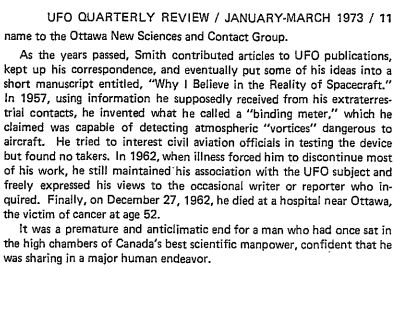
Many other relevant videos and mp3 files can be found online.
A relatively extensive collection of audio material relating to Wilbert B Smith can be found on the “Check The Evidence” website:
www.checktheevidence.com...
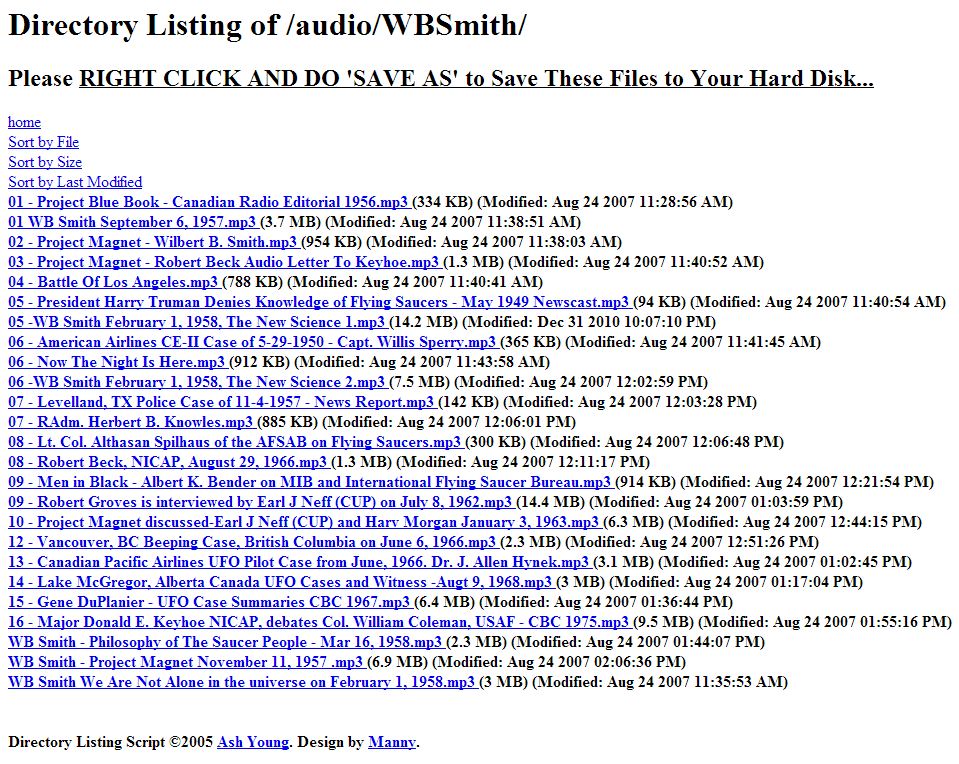
Wilbert Smith wrote quite a bit about UFOs. Some of his articles appeared in the Flying Saucer Review (“FSR”) magazine – including at the following references:
Smith, Wilbert – Flying Saucer Review. Volume 4, Number 3, (May-June 1958) pages 10-11
Smith, Wilbert – Flying Saucer Review, Volume 4, Number 6 (November/December 1958) pages 8-11
Smith, Wilbert – Flying Saucer Review, Volume 5, Number 2 (March/April 1959) pages 12-14, 31
Smith, Wilbert – Flying Saucer Review, Volume 5, Number 5 (September/October 1959) pages 18-20
Smith, Wilbert – Flying Saucer Review, Volume 6, Number 3
Smith, Wilbert – Flying Saucer Review, Volume 7, Number 2 (March/April 1961) pages 7-8
Smith, Wilbert – Flying Saucer Review, Volume 9, Number 5 (September/October 1963) pages 13-16
Smith, Wilbert – Flying Saucer Review, Volume 9, Number 6 (November/December 1963) pages 11-14
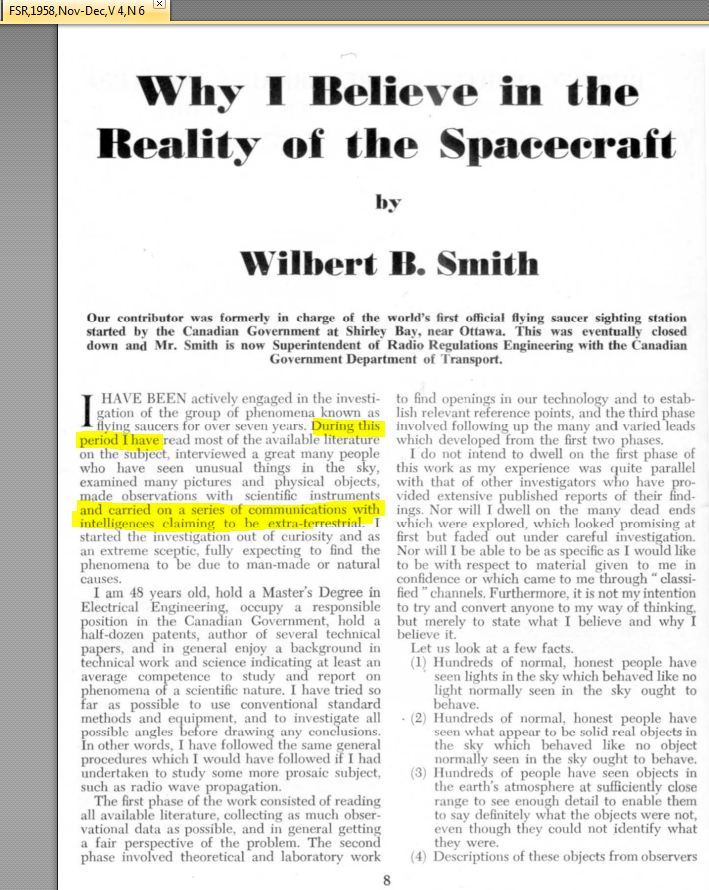
For example, Timothy Good’s book “Above Top Secret” discusses Wilbert Smith at pages 178-184, 198-200 (in Chapter 8) of the Sidgwick & Jackson hardback edition (with the same page numbering in the Guild Publishing hardback edition and the Grafton paperback edition). That section can be found online on the Stealthskater website and states that Wilbert Smith was
senior radio engineer with the Canadian government Department of Transport at the time and a highly respected scientist who held a master's degree in electrical engineering and several patents.
Similarly, Michael Strainic wrote a biography for the NICAP web site (2002) at:
www.nicap.org...
“For the most part, however, the picture is clear: Wilbert B. Smith was a sensible and serious scientist who held an important post within his government”
A rather different impression about Wilbert Smith is given in the following comments from sceptics:
(b) A “Magonia” book review refers to Wilbert Smith as a:
pelicanist.blogspot.co.uk...
“anti gravity flying saucer propulsion theory / contactee hugging crank who led a Canadian official or semi official UFO investigation back in the early 1950s”
(b) Christopher D Allan, in a relatively detailed article on Wilbert Smith, refers to him as:
www.ufoupdateslist.com...
“an insignificant Canadian scientist of long ago”
Particularly noteworthy for their detail (with supporting references/links) and their insight, are various articles by Paul Kimball (a Canadian film-maker and ufologist) relating to Wilbert Smith, particularly Paul Kimball’s articles on Wilbert Smith’s competence and credibility:
redstarfilms.blogspot.co.uk...
redstarfilms.blogspot.co.uk...
The latter article includes details of Wilbert Smith’s claims to have spent “many hours conversing with people from elsewhere”.

The issue of Wilbert Smith’s claims to have had contact with people from elsewhere is covered in quite a few of the discussions of Wilbert Smith’s work, e.g. in this discussion by Stuart Nixon in a NICAP publication (Nixon, 1973) - which makes it all the more surprising that this issue is (deliberately?) overlooked in some of the more pro-ETH discussions of Wilbert Smith and Project Magnet:

Many other relevant videos and mp3 files can be found online.
A relatively extensive collection of audio material relating to Wilbert B Smith can be found on the “Check The Evidence” website:
www.checktheevidence.com...

Wilbert Smith wrote quite a bit about UFOs. Some of his articles appeared in the Flying Saucer Review (“FSR”) magazine – including at the following references:
Smith, Wilbert – Flying Saucer Review. Volume 4, Number 3, (May-June 1958) pages 10-11
Smith, Wilbert – Flying Saucer Review, Volume 4, Number 6 (November/December 1958) pages 8-11
Smith, Wilbert – Flying Saucer Review, Volume 5, Number 2 (March/April 1959) pages 12-14, 31
Smith, Wilbert – Flying Saucer Review, Volume 5, Number 5 (September/October 1959) pages 18-20
Smith, Wilbert – Flying Saucer Review, Volume 6, Number 3
Smith, Wilbert – Flying Saucer Review, Volume 7, Number 2 (March/April 1961) pages 7-8
Smith, Wilbert – Flying Saucer Review, Volume 9, Number 5 (September/October 1963) pages 13-16
Smith, Wilbert – Flying Saucer Review, Volume 9, Number 6 (November/December 1963) pages 11-14

One of the Canadian documents relating to Wilbert Smith and Project Magnet that I found particularly interesting is Page 6780 (i.e. Part 23, page 180
of 300 - e002997366), which is a memo relating to the Project Magnet file which
states : “At no time should it be made available to the public”:

This document has previously been highlighted by some researchers (e.g. in various items by Grant Cameron, e.g. on his website and in a post on the UFO Updates discussion List).
This memo was also discussed by skeptic Christopher D Allan in his relatively detailed article on Wilbert Smith mentioned above. In that article, C D Allan suggested : “the Canadian authorities wanted to allow a period for interested parties to view the files before disposing of them; hardly the action of an authority intent on covering up important UFO data”. However, C D Allen appears to have misread the memo. He says the memo “down-classified the files to the 'confidential' level, adding that they would be made available to persons in a bona-fide organisation”. In fact, the memo fairly clearly states that the material in the relevant file covers documents “relating to the studies behind project Magnet and, indeed, records much of the discussion in the Department of Transport surrounding project ‘Magnet”” and it this FILE which it was said should not be made available to the public at any time. The relevant documentation therefore went beyond the report itself but it was ONLY THE REPORT which that memo envisaged would be made available to some interested parties. Anyway, my point is merely to highlight that when considering partial extracts from the report presented by researchers, it is desirable to check the underlying document itself to see the precise wording of the relevant comments in their full context. The purpose of making these searchable PDFs available is to make such checking easier and quicker.
In any event, I found the memo interesting because it is yet another example of (unnecessary?) secrecy in relation to UFO studies. In relation to many of these UFO documents, an express or implied reason for the secrecy is to avoid faming the flames of interest in UFOs by giving any indication that any government agency has conducted any relevant investigation. However, in virtually all such cases that motive for secrecy has proved to be counter-productive. Eventually, information about the study has been revealed along with material indicating that the government authorities wanted to keep the relevant material from the public. This has fanned conspiracy theories in relation to government investigations into UFO reports.
Secrecy in respect of UFO reports and investigations feeds allegations of a "cosmic watergate" (a term used by some ufologists when alleging that Governments are concealing evidence of extraterrestrial visitors to this planet).
Even the University of Colorado report on UFOs ("the Condon Report") contains fairly strident criticisms of secrecy in relation to ufo reports. The Condon Report is not generally considered to be biased in favour of ETH proponents. However, a section by Condon himself includes the following: "It would have been wise to have declassified all or nearly all of the previous reports of investigations of flying saucer incidents .. But secrecy was maintained. This opened the way for intensification of the ‘aura of mystery’ which was already impairing public confidence in the Department of Defense. Official secretiveness also fostered systematic sensationalized exploitation of the idea that a government conspiracy existed to conceal the truth."

This document has previously been highlighted by some researchers (e.g. in various items by Grant Cameron, e.g. on his website and in a post on the UFO Updates discussion List).
This memo was also discussed by skeptic Christopher D Allan in his relatively detailed article on Wilbert Smith mentioned above. In that article, C D Allan suggested : “the Canadian authorities wanted to allow a period for interested parties to view the files before disposing of them; hardly the action of an authority intent on covering up important UFO data”. However, C D Allen appears to have misread the memo. He says the memo “down-classified the files to the 'confidential' level, adding that they would be made available to persons in a bona-fide organisation”. In fact, the memo fairly clearly states that the material in the relevant file covers documents “relating to the studies behind project Magnet and, indeed, records much of the discussion in the Department of Transport surrounding project ‘Magnet”” and it this FILE which it was said should not be made available to the public at any time. The relevant documentation therefore went beyond the report itself but it was ONLY THE REPORT which that memo envisaged would be made available to some interested parties. Anyway, my point is merely to highlight that when considering partial extracts from the report presented by researchers, it is desirable to check the underlying document itself to see the precise wording of the relevant comments in their full context. The purpose of making these searchable PDFs available is to make such checking easier and quicker.
In any event, I found the memo interesting because it is yet another example of (unnecessary?) secrecy in relation to UFO studies. In relation to many of these UFO documents, an express or implied reason for the secrecy is to avoid faming the flames of interest in UFOs by giving any indication that any government agency has conducted any relevant investigation. However, in virtually all such cases that motive for secrecy has proved to be counter-productive. Eventually, information about the study has been revealed along with material indicating that the government authorities wanted to keep the relevant material from the public. This has fanned conspiracy theories in relation to government investigations into UFO reports.
Secrecy in respect of UFO reports and investigations feeds allegations of a "cosmic watergate" (a term used by some ufologists when alleging that Governments are concealing evidence of extraterrestrial visitors to this planet).
Even the University of Colorado report on UFOs ("the Condon Report") contains fairly strident criticisms of secrecy in relation to ufo reports. The Condon Report is not generally considered to be biased in favour of ETH proponents. However, a section by Condon himself includes the following: "It would have been wise to have declassified all or nearly all of the previous reports of investigations of flying saucer incidents .. But secrecy was maintained. This opened the way for intensification of the ‘aura of mystery’ which was already impairing public confidence in the Department of Defense. Official secretiveness also fostered systematic sensationalized exploitation of the idea that a government conspiracy existed to conceal the truth."
edit on 20-11-2012 by IsaacKoi because: (no reason given)
The counter-productive nature of secrecy in relation to UFO investigations has been commented upon by various sceptics. For example, Carl Sagan has
made the following comment in relation to the classification of UFO reports:
Similarly, Steuart Campbell (another UFO skeptic) has said:
It is ironic that a British Ministry of Defence report (“the Condign Report”) was itself kept secret for 6 years despite referring to a covert study group in the USA during the 1950s and commenting that "the covertness of this investigation subsequently contributed greatly to charges of a government 'cover-up'" (Volume 1, Chapter 1, page 1, para 2):
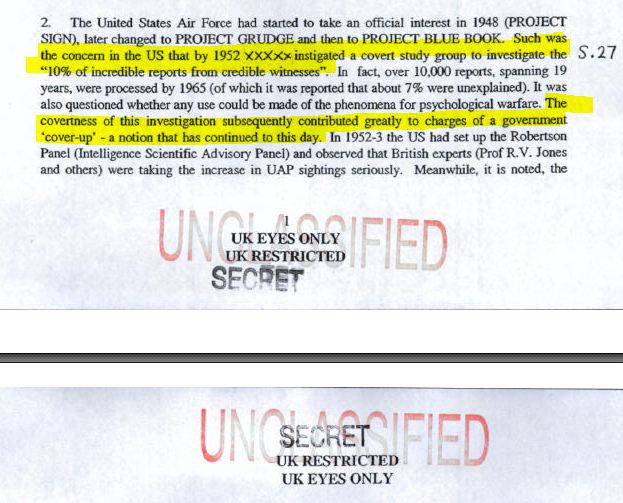
It seems that even when government officials recognise the implications of previous mistakes, they do not always act on those insights.
"The armed forces have a tendency to classify everything in sight. Then the fact that such cases are classified starts rumours. Somebody who is in a position to know realizes the Air Force does have relevant data; and it is just a short step to the idea of official conspiracy to suppress the truth. Had the data not been classified, then independent scientific judgments would have been possible. In many cases, such independent scientific analysis would show that the cases have a natural explanation. The culprit is classification. I have a friend who says that in America today if you're not a little paranoid you're out of your mind. The military has a responsibility not to add further to the paranoia".
Carl Sagan in "UFO's: A Scientific Debate" (1972) (edited
by Carl Sagan and Thornton Page) at pages 273-274 (in Chapter
14) of the Norton paperback edition.
Similarly, Steuart Campbell (another UFO skeptic) has said:
In general, governmental agencies do not have the skill or knowledge to explain UFO reports. But rather than admit this, they either offer ridiculous explanations or conceal information that would enable others to explain them. However, the secrecy involved gives the impression that something important is being concealed, fuelling the UFO myth. Governments are victims of their own preoccupation with secrecy." [23]
Steuart Campbell in his book "The UFO Mystery Solved" (1994) at page 184 (in Chapter 12) of the Explicit Books softcover edition.
It is ironic that a British Ministry of Defence report (“the Condign Report”) was itself kept secret for 6 years despite referring to a covert study group in the USA during the 1950s and commenting that "the covertness of this investigation subsequently contributed greatly to charges of a government 'cover-up'" (Volume 1, Chapter 1, page 1, para 2):

It seems that even when government officials recognise the implications of previous mistakes, they do not always act on those insights.
SECTION D : OTHER SELECTED PAGES
One series of documents within the Canadian files relates to a report of a fallen “unidentified object” sent to Canadian authorities, with one of the more unusual explanations I’ve seen for such reports. Four pages from that series of documents are shown below (a to d).
(a) Page 6621 (i.e. part 23, page 1 of 300 – e002799666):
Letter from witness stating that on 3rd August 1965 her son had been riding his bicycle when “an object fell from the sky barely missing him” and asking if the government could identify the object:
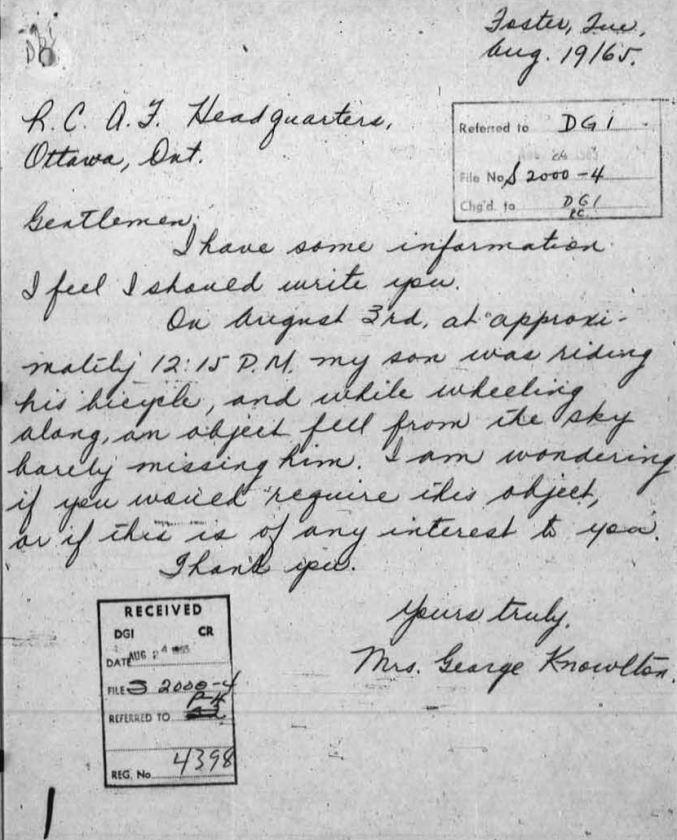
(b) Page 6622 (i.e. part 23, page 2 of 300 - e002799667):
Statement that “the government is interested in any UFO be it a meteorite, an aircraft part or a flying saucer”
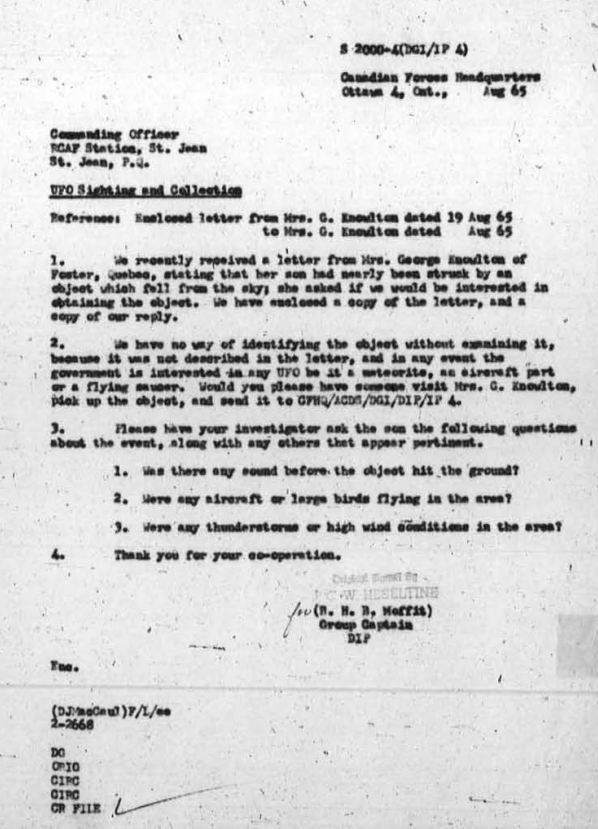
(c) Page 6623 (i.e. part 23, page 3 of 300 - e002799668):
Letter enclosing object
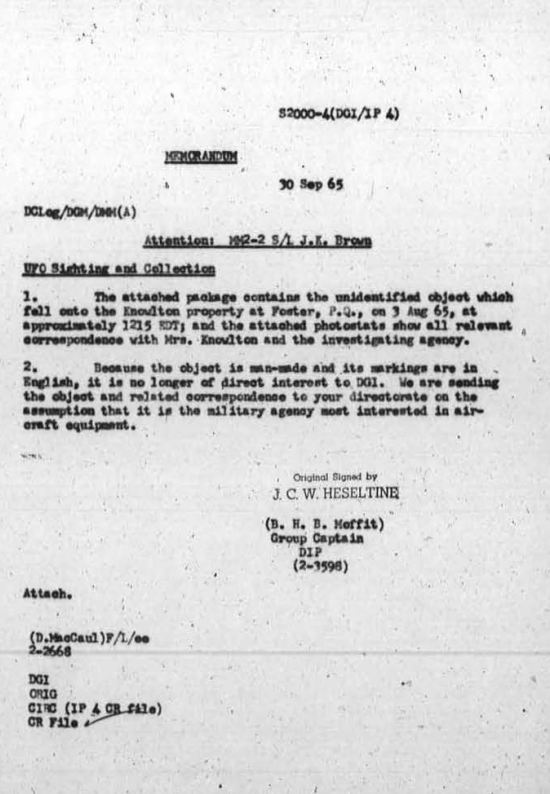
(d) Page 6624 (i.e. part 23, page 4 of 300 - e002799669):
Object identified as an oil breather cap for an automobile.
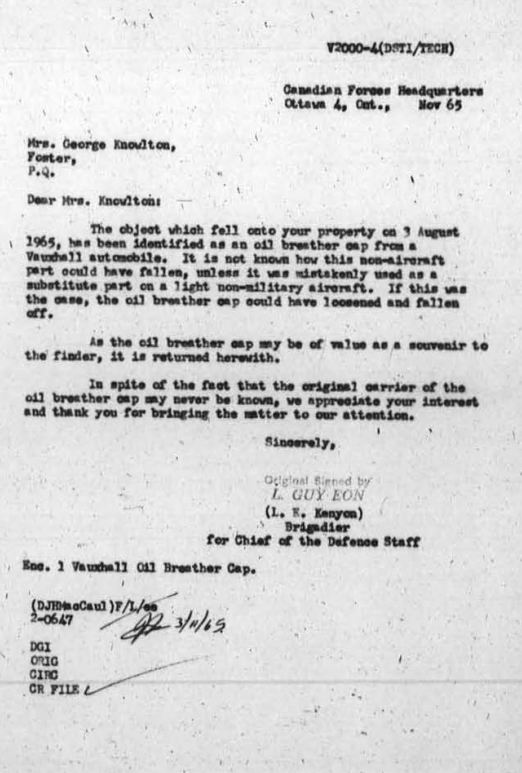
Other documents that caught my eye included a memo about an object reported by several witnesses. They reporting an object flying overhead in October 1980. Three men in a camper reported that the camper shook and they felt like their bodies were rising in the air:
Memo at Page 4655 (e002749198):
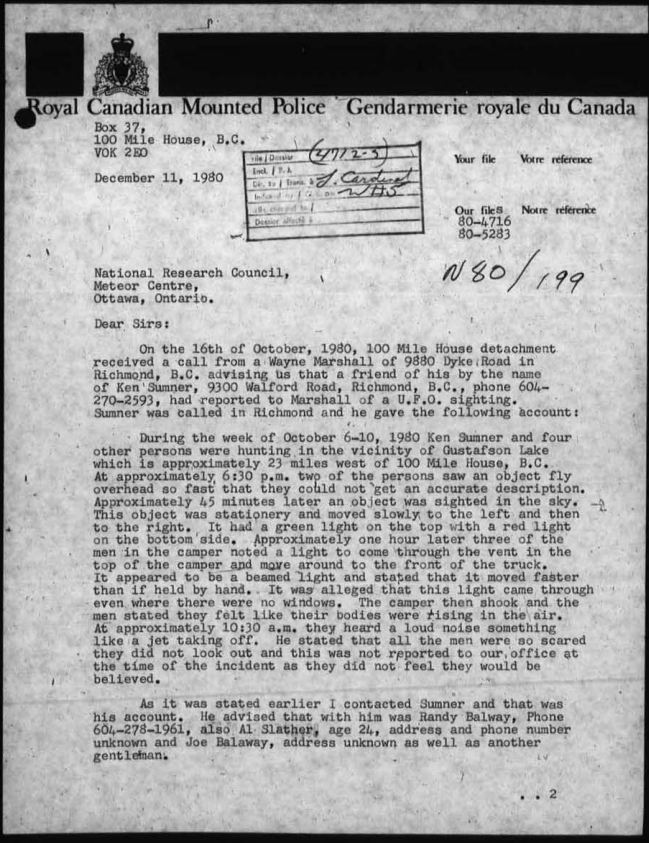
Memo concluding that witness saw “something which cannot be unexplained”:
Page 4807 (e002749361 ) and 4808 (e002749362):
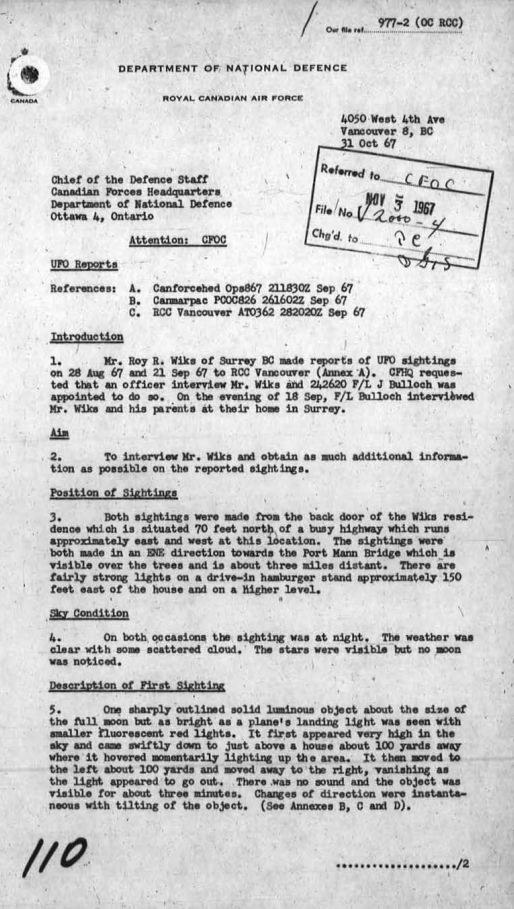
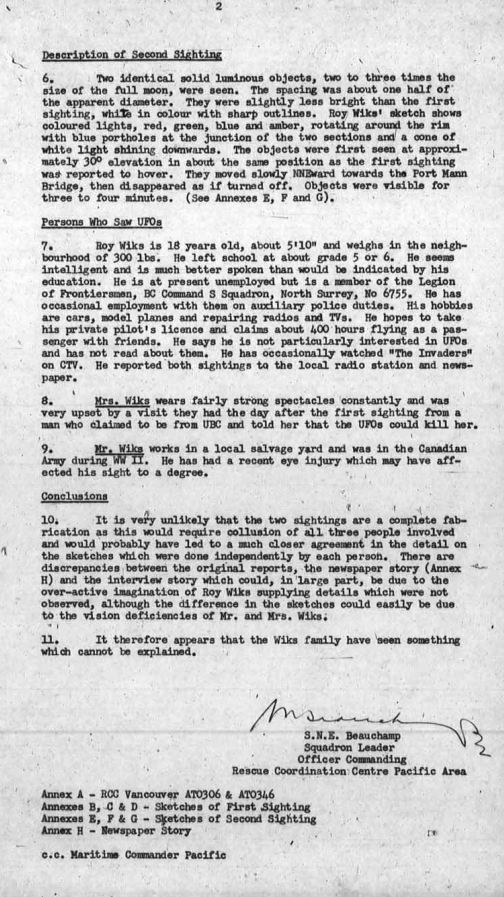
Memo re Condon
Page 4944 (e002749501)

Condon letter page 1:
Page 5220 (e002749789):
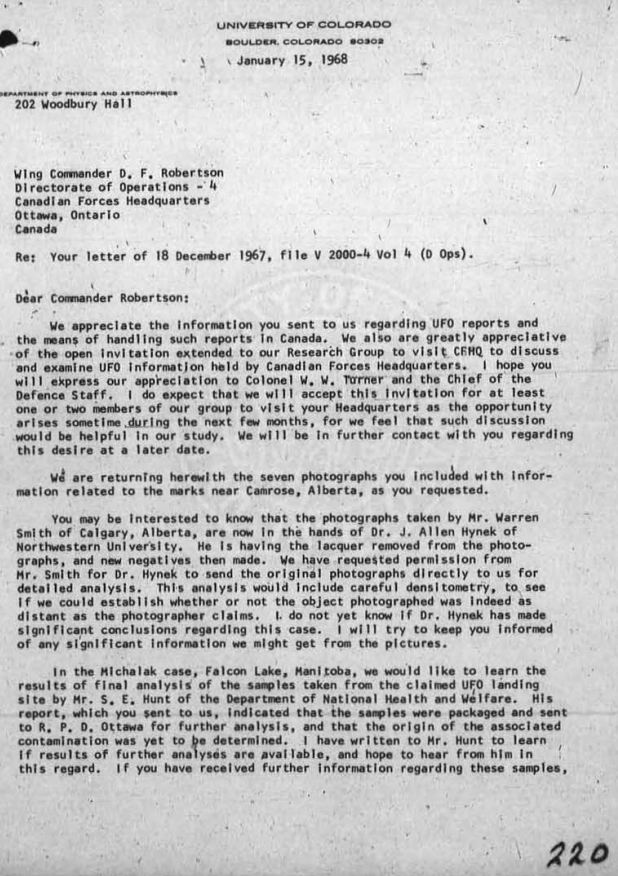
Condon letter page 2
Page 5221 (e002749790):
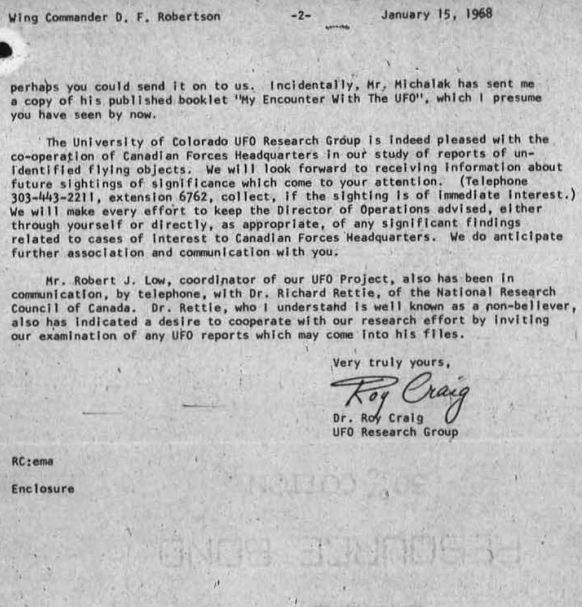
e002751015: November 1962 memo about a report of a sighting of an object followed by a “terrific explosion” (with surrounding pages discussing the possibility of a meteorite sighting and/or space debris)
Page 6339
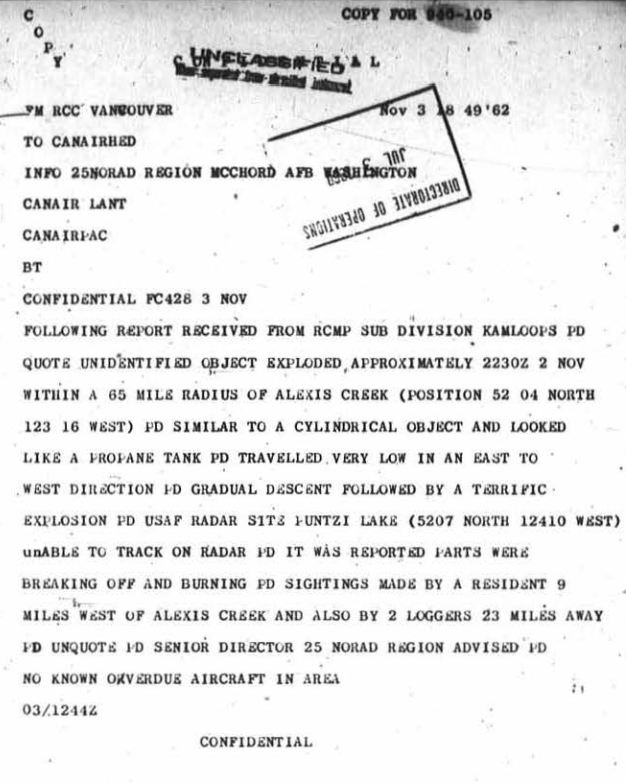
My personal favourite (simply because I wonder how the recipient felt when reading the document…) remains the official November 1968 memo with a title beginning “UFO found …”. As discussed in my previous thread relating to the Canadian documents, that memo referred to a metal fragment, examination of which “revealed the exhibit had likely formed part of a vehicle that travelled in outer space”, and attached relevant photographs.
e003000440: Page 7767
[atsimg]http://files.abovetopsecret.com/images/member/4dbfb62032a7.jpg[/atsimg]
The photos in that section of the file include the following:
e003000429 : Page 7756
[atsimg]http://files.abovetopsecret.com/images/member/8df76a28c209.jpg[/atsimg]
Section E : Burnt by a UFO? The Falcon Lake incident
As many of you may know Steve Michalak claimed to see, and be injured by, a UFO near Falcon Lake, Canada on 20 May 1967.
He claimed that a UFO landed near him in the woods, and that when he approached the object and touched it with his gloved hand, it soared away, its exhaust blast leaving a patterned burn on his abdomen and making him ill.
This has become one of the classic cases in the history of ufology. This incident is Case 50 in my "Top 100" article, since this case was referred to in 54 of the books covered by that article. This incident also featured in a document (“the Rockefeller Briefing Document”) endorsed by Dr Mark Rodeghier (President of CUFOS), Richard Hall (Chairman of FUFOR) and Walter Andrus (President of MUFON) as containing “the best available evidence for the existence of UFOs”.
The Falcon Lake incident has also been discussed in several threads on ATS (including “Get to close and you`ll get burned!!!!!!” and 1967 UFO Encounter, Falcon Lake (Canada) CE2 and has been covered in several UFO documentaries.
Several relevant videos can be found on Youtube, including the following segment from the Unsolved Mysteries TV series:
The Falcon Lake incident was one of the UFO incidents investigated as part of the famous (or infamous…) UFO study of headed by Dr Edward Condon of the University of Colorado in the 1960s. A member of the Condon team, Roy Craig, visited Canada as part of the investigation of this incident. As outlined below, the results of Roy Craigs’ investigation were detailed in the Condon Report. The Condon Report coverage does not refer to Michalak by name, but it is clearly Case 22 in the Condon report. Roy Craig subsequently devoted a chapter (Chapter 2, i.e. pages 14 to 27) of his own book to this incident. The relevant chapter can be read online – see “UFOs: an insider’s view of the official question” on Google Books.
Those interested can now read several sets of official Canadian documents relating to this incident.
I have found two blocks of documentation relating to this incident, at URLs ending with numbers from e002749596 (Page 5032) to e002749714 (Page 5147) and from e002999671 (Page 7069) to e002999770 (Page 7163). (I have also seen a few documents relating to this incident scattered through the files).
Various press clippings appear in the Canadian files and give an impression of the public interest in this particular case:
Page 5044 (e002749608):
data2.collectionscanada.gc.ca...
[atsimg]http://files.abovetopsecret.com/images/member/4d442c36885b.jpg[/atsimg]
Page 5045 (e002749609):
data2.collectionscanada.gc.ca...
[atsimg]http://files.abovetopsecret.com/images/member/2a37394485ce.jpg[/atsimg]
Page 5118 (e002749683):
data2.collectionscanada.gc.ca...
[atsimg]http://files.abovetopsecret.com/images/member/94d002f1e518.jpg[/atsimg]
The disclosed Canadian files also include this drawing by Michalak (at Page 5046 - e002749610):
data2.collectionscanada.gc.ca...
[atsimg]http://files.abovetopsecret.com/images/member/e5c8d0af9d0d.jpg[/atsimg]
A medical report on Michalak’s injuries appears in the Canadian files (at Page 5089 - e002749654):
data2.collectionscanada.gc.ca...
[atsimg]http://files.abovetopsecret.com/images/member/f2f1d518e76d.jpg[/atsimg]
Photos of Michalak’s injury appear on numerous websites and can also be found in the official Candian files (at Page 5059 - e002749623) :
data2.collectionscanada.gc.ca...
[atsimg]http://files.abovetopsecret.com/images/member/473474b0766a.jpg[/atsimg]
A copy of a photo of Michalak’s abdomen appears on page 24 of Roy Craig’s own book, referred to above, (see “UFOs: an insider’s view of the official question” on Google Books). The relevant page is shown below for ease of reference.
[atsimg]http://files.abovetopsecret.com/images/member/d2d671b6fb6d.jpg[/atsimg]
The undershirt shown in the bottom half of that page of Roy Craig’s own book is also discussed in the section relating to Case 22 in the Condon report:
The point made by Roy Craig in the Condon Report about the patterned burn being on the back of the undershirt when Michalak had only been burned on the abdomen obviously impressed him, given that he highlights this point again in his book.
The disclosed Canadian files include several documents regarding radiation in relation to this incident, including the one below:
data2.collectionscanada.gc.ca...
[atsimg]http://files.abovetopsecret.com/images/member/585432ddff3c.jpg[/atsimg]
data2.collectionscanada.gc.ca...
[atsimg]http://files.abovetopsecret.com/images/member/e5c8d0af9d0d.jpg[/atsimg]
A medical report on Michalak’s injuries appears in the Canadian files (at Page 5089 - e002749654):
data2.collectionscanada.gc.ca...
[atsimg]http://files.abovetopsecret.com/images/member/f2f1d518e76d.jpg[/atsimg]
Photos of Michalak’s injury appear on numerous websites and can also be found in the official Candian files (at Page 5059 - e002749623) :
data2.collectionscanada.gc.ca...
[atsimg]http://files.abovetopsecret.com/images/member/473474b0766a.jpg[/atsimg]
A copy of a photo of Michalak’s abdomen appears on page 24 of Roy Craig’s own book, referred to above, (see “UFOs: an insider’s view of the official question” on Google Books). The relevant page is shown below for ease of reference.
[atsimg]http://files.abovetopsecret.com/images/member/d2d671b6fb6d.jpg[/atsimg]
The undershirt shown in the bottom half of that page of Roy Craig’s own book is also discussed in the section relating to Case 22 in the Condon report:
The undershirt which Mr. A presented had been ripped apart in front, where it was burned. It also carried a patterned burn centered high on the back, the pattern matching, according to Mr. A, the pattern of the UFO's exhaust openings from which the burning vapors had spurted. Mr. A had been burned only on the abdomen, with slight singeing of the forehead. The reason for the presence of a patterned burn on the back of the undershirt was not obvious.
The point made by Roy Craig in the Condon Report about the patterned burn being on the back of the undershirt when Michalak had only been burned on the abdomen obviously impressed him, given that he highlights this point again in his book.
The disclosed Canadian files include several documents regarding radiation in relation to this incident, including the one below:
data2.collectionscanada.gc.ca...
[atsimg]http://files.abovetopsecret.com/images/member/585432ddff3c.jpg[/atsimg]
The relevant pages in the Condon report includes two discussions of the radioactivity,
including this section:
Samples of soil and moss from the area, portions of the burned shirt, and a six-foot measuring tape which Mr. A had left behind were brought to city A. All three were radioactive. When sent to city B for analysis, they were found to be so strongly radioactive that the Radiation Protection Division of the Dept. of Health and Welfare considered restricting entry to the forest area from which they allegedly were taken. A careful check of the site by a representative of this department revealed that the perimeter of the "landing circle" and beyond were free of radioactive contamination. According to his report:
“A thorough survey of the landing area was carried out, using a Tracerlab SU14, Admiral Radiac 5016, and a Civil Defense CDV 700 survey meter. One small area was found to be contaminated. This was located across the crown of the rock. There was a smear of contamination about 0.5 x 8.0 inches on one side of the crack. There was also some lichen and ground vegetation contaminated just beyond the smear. The whole contaminated area was no larger than 100 square inches. All water runoff areas were checked for possible contamination, but nothing was found”.
No representative of an independent or official agency was present when the circular area alleged to be the landing site was rediscovered. In spite of an RCMP understanding with Mr. A that no evidence should be removed from the area should he relocate it, radioactive soil samples, (fortuitously selected from the small contaminated area), remnants of cloth, and the measuring tape were represented as having been removed from the area. Why the cloth remnants and the tape were radioactive was never explained. While these items could have been contaminated by contact with the soil samples, reports received by the project indicated that the items were in separate plastic bags, and major contamination would not be expected. The partially-burned undershirt had earlier been found not to carry radioactive contamination. The tape would have been left some 160 ft. from the landing circle, in an area found to be free of radioactive contamination.
Other individuals checked the site for radioactivity later. One of these was Mr. E. J. Epp of city A, who searched the site in Fall of 1967 and found no radioactive material. At the project's suggestion, he had the records of the Dept. of Mines and Natural Resources searched for mineral claims in the area filed by Mr. A. This was requested because of the possibility that Mr. A had deliberately misdirected the earlier searches in order to protect mineral claims. Such claims were filed by him, but not until later in the Fall.
The [Condon] project never received a final report of the analyses of the soil samples taken by the Dept. of Health and Welfare. The origin of this material is therefore an open question.
The Canadian files contain a complete (if rather poorly photocopied) copy of a commercial publication of Michalak’s story in a booklet, beginning at
Page 5093 (e002749658):
data2.collectionscanada.gc.ca...
A better copy of the front page of that booklet (and a couple of the photos inside it) can be found at this link and is shown below:
[atsimg]http://files.abovetopsecret.com/images/member/8e45fdc47a1f.jpg[/atsimg]
The Condon report made the following comments in relation to this booklet
The official Canadian files also include a multiple-page transcript of an interview of Michalak by the RCMP, the first page of which is shown below:
data2.collectionscanada.gc.ca...
[atsimg]http://files.abovetopsecret.com/images/member/b196bd8973db.jpg[/atsimg]
data2.collectionscanada.gc.ca...
A better copy of the front page of that booklet (and a couple of the photos inside it) can be found at this link and is shown below:
[atsimg]http://files.abovetopsecret.com/images/member/8e45fdc47a1f.jpg[/atsimg]
The Condon report made the following comments in relation to this booklet
“This account differs in some aspects from Mr. A's original reports. In the booklet, for example, Mr. A is reported to have stuck his head into the open hatch of the "saucer" and observed a maze of randomly flashing lights inside the craft. In earlier accounts, Mr. A stated that he avoided going near the hatch and was unable to see inside it because of the brightness of the light coming from it. The account was chronologically jumbled, and showed a carelessness with fact.”
The official Canadian files also include a multiple-page transcript of an interview of Michalak by the RCMP, the first page of which is shown below:
data2.collectionscanada.gc.ca...
[atsimg]http://files.abovetopsecret.com/images/member/b196bd8973db.jpg[/atsimg]
Section F : UFO crash? The Shag Harbour incident
The Shag Harbour, Nova Scotia incident occurred on 4 October 1967, involving claims that a UFO descended into the water. The Wikipedia entry in relation to this incident includes the following:
The Shag Harbour UFO Incident was the reported impact of an unknown large object into waters near Shag Harbour, a tiny fishing village in the Canadian province of Nova Scotia on October 4, 1967.
The impact was investigated by various civilian (Royal Canadian Mounted Police and Canadian Coast Guard) and military (Royal Canadian Navy and Royal Canadian Air Force) agencies of the Government of Canada. The RCN conducted at least one underwater search to attempt to locate the remains of any associated objects. The Government of Canada declared that no known aircraft was involved and the source of the impact remains unknown to this day. It is one of very few cases where government agency documents have formally declared an unidentified flying object was involved.
This incident is the subject of a book entitled “Dark Object” (2001) by Don Ledger and Chris Styles. It has also been covered in several threads on ATS (Jkrog08’s thread UFO Crash Event: Shag Harbor, 1967) and in several documentaries. Those documentaries include the History Channel’s documentary entitled “Canada’s Roswell” (which formed part of the 2006 season of the “UFO Files” series):
The disclosed Canadian files include documents relating to the Shag Harbour incident at URLs ending with e002749390 onwards.
A few of the relevant documents are shown below.
Page 4835 (e002749390):
data2.collectionscanada.gc.ca...
[atsimg]http://files.abovetopsecret.com/images/member/01a4fbe422c1.jpg[/atsimg]
Page 4836 (e002749391):
data2.collectionscanada.gc.ca...
[atsimg]http://files.abovetopsecret.com/images/member/02a06ff4514b.jpg[/atsimg]
Page 4846 (e002749401):
data2.collectionscanada.gc.ca...
[atsimg]http://files.abovetopsecret.com/images/member/1cb1773fb4c3.jpg[/atsimg]
Page 4838 (e002749393):
data2.collectionscanada.gc.ca...
[atsimg]http://files.abovetopsecret.com/images/member/12f1fc24e901.jpg[/atsimg]
A few of the relevant documents are shown below.
Page 4835 (e002749390):
data2.collectionscanada.gc.ca...
[atsimg]http://files.abovetopsecret.com/images/member/01a4fbe422c1.jpg[/atsimg]
Page 4836 (e002749391):
data2.collectionscanada.gc.ca...
[atsimg]http://files.abovetopsecret.com/images/member/02a06ff4514b.jpg[/atsimg]
Page 4846 (e002749401):
data2.collectionscanada.gc.ca...
[atsimg]http://files.abovetopsecret.com/images/member/1cb1773fb4c3.jpg[/atsimg]
Page 4838 (e002749393):
data2.collectionscanada.gc.ca...
[atsimg]http://files.abovetopsecret.com/images/member/12f1fc24e901.jpg[/atsimg]
SECTION G : REFERENCES
The purpose of this thread is merely to highlight the fact that the archive of Canadian documents which I’ve previously outlined in another thread: www.abovetopsecret.com...
Further details of many of the above issues can be found online and in various UFO books. Anyone wanting to look into any of these issues in depth may find the webpages mentioned below useful since these pages contain tables of references which can be sorted by author, year of publication and the length of discussion:
Wilbert Smith:
www.isaackoi.com...
Wilbert Smith’s memo dated 21st November 1950:
www.isaackoi.com...
Project Magnet:
www.isaackoi.com...
Second Storey:
www.isaackoi.com...
Other References:
Allan, Christopher D “WILBERT SMITH and MJ-12” in UFO BRIGANTIA_, July 1990. Available online at:
www.ufoupdateslist.com...
Birnes, William in his “The UFO Magazine UFO Encyclopedia” (2004) at pages 289-292 (in an entry entitled “Smith, Wilbert Brockhouse”) of the Pocket Books softcover edition.
Bray, Arthur in “The Encyclopedia of UFOs” (1980) edited by Ronald Story at pages 336-337 (in an entry entitled “Smith, Wilbert B[rockhouse]”) of the NEL hardback edition.
Bruce Knapp, Errol (Editor) : “Wilbert Brockhouse Smith” from material by Arthur Bray, David Haisell and Greg Kanon. Online at:
www.virtuallystrange.net...
Grant Cameron items referred to above:
presidentialufo.com...
ufoupdateslist.com...
Campagna, Palmiro in his “The UFO Files: The Canadian Connection Exposed” (1998) generally, particularly at pages x, xi (in the “Preface to the Paperback Edition”), 15-17, 29-36 (in Chapter 2), 37-47 (in Chapter 3 generally), 52-60 (in Chapter 4), 140-143, 144-145, 150 (in Chapter 10), 153-155 (in Chapter 11), 162-166, 167-168 (in the Postscript) of the Stoddart softcover edition.
Clark, Jerome in his “The UFO Encyclopedia: The Phenomenon from the Beginning - 2ndedition” (1998) in Volume 2:L-Z at at pages 813-816 (in an entry entitled “Sarbacher Episode”) and pages 851-854 (in an entry entitled “Smith, Wilbert Brockhouse (1910-1962)”) of the Omnigraphics hardback edition.
Good, Timothy in his “Above Top Secret” (1987) at pages 178-184, 198-200 (in Chapter 8) of the Sidgwick & Jackson hardback edition (with the same page numbering in the Guild Publishing hardback edition and the Grafton paperback edition). Relevant extract from Tim Good’s book “Above Top Secret” at:
www.stealthskater.com...
Good, Timothy in his “Beyond Top Secret” (1996) at pages 180-190, 206-208 (in Chapter 10) of the Sidgwick & Jackson hardback edition (with the same page numbering in the Pan paperback edition).
Keyhoe, Donald E in his “Flying Saucers from Outer Space” (1953) at pages 128, 130-149, 212-217 of the Henry Holt hardback edition, pages 130, 131-151, 211-215 of the Tandem paperback edition (in Chapter 8, “The Canadian Project” and in Chapter 12
Kimball, Paul. Various articles on his Redstarfilms blog, including at:
redstarfilms.blogspot.co.uk...
NICAP’s The UFO Investigator 1, 2 (August, September 1957) page 23
Nixon, Stuart - NICAP UFO Quarterly 1, 1 (January/March 1973) pages 2-11
Randles, Jenny in her “The Little Giant Encyclopedia of UFOs” (2000) at page 275 (in Part 3, “UFOs Worldwide”) of the Sterling softcover edition.
Spencer, John in his “The UFO Encyclopedia” (1991) at page 283 (in an entry entitled “Smith, Wilbert B”) of the Guild hardback edition (with the same page numbering in the Avon softcover edition) at pages 333-334 of the Headline paperback edition.
Strainic, Michael – Biography for the NICAP web site (2002) at www.nicap.org...
The purpose of this thread is merely to highlight the fact that the archive of Canadian documents which I’ve previously outlined in another thread: www.abovetopsecret.com...
Further details of many of the above issues can be found online and in various UFO books. Anyone wanting to look into any of these issues in depth may find the webpages mentioned below useful since these pages contain tables of references which can be sorted by author, year of publication and the length of discussion:
Wilbert Smith:
www.isaackoi.com...
Wilbert Smith’s memo dated 21st November 1950:
www.isaackoi.com...
Project Magnet:
www.isaackoi.com...
Second Storey:
www.isaackoi.com...
Other References:
Allan, Christopher D “WILBERT SMITH and MJ-12” in UFO BRIGANTIA_, July 1990. Available online at:
www.ufoupdateslist.com...
Birnes, William in his “The UFO Magazine UFO Encyclopedia” (2004) at pages 289-292 (in an entry entitled “Smith, Wilbert Brockhouse”) of the Pocket Books softcover edition.
Bray, Arthur in “The Encyclopedia of UFOs” (1980) edited by Ronald Story at pages 336-337 (in an entry entitled “Smith, Wilbert B[rockhouse]”) of the NEL hardback edition.
Bruce Knapp, Errol (Editor) : “Wilbert Brockhouse Smith” from material by Arthur Bray, David Haisell and Greg Kanon. Online at:
www.virtuallystrange.net...
Grant Cameron items referred to above:
presidentialufo.com...
ufoupdateslist.com...
Campagna, Palmiro in his “The UFO Files: The Canadian Connection Exposed” (1998) generally, particularly at pages x, xi (in the “Preface to the Paperback Edition”), 15-17, 29-36 (in Chapter 2), 37-47 (in Chapter 3 generally), 52-60 (in Chapter 4), 140-143, 144-145, 150 (in Chapter 10), 153-155 (in Chapter 11), 162-166, 167-168 (in the Postscript) of the Stoddart softcover edition.
Clark, Jerome in his “The UFO Encyclopedia: The Phenomenon from the Beginning - 2ndedition” (1998) in Volume 2:L-Z at at pages 813-816 (in an entry entitled “Sarbacher Episode”) and pages 851-854 (in an entry entitled “Smith, Wilbert Brockhouse (1910-1962)”) of the Omnigraphics hardback edition.
Good, Timothy in his “Above Top Secret” (1987) at pages 178-184, 198-200 (in Chapter 8) of the Sidgwick & Jackson hardback edition (with the same page numbering in the Guild Publishing hardback edition and the Grafton paperback edition). Relevant extract from Tim Good’s book “Above Top Secret” at:
www.stealthskater.com...
Good, Timothy in his “Beyond Top Secret” (1996) at pages 180-190, 206-208 (in Chapter 10) of the Sidgwick & Jackson hardback edition (with the same page numbering in the Pan paperback edition).
Keyhoe, Donald E in his “Flying Saucers from Outer Space” (1953) at pages 128, 130-149, 212-217 of the Henry Holt hardback edition, pages 130, 131-151, 211-215 of the Tandem paperback edition (in Chapter 8, “The Canadian Project” and in Chapter 12
Kimball, Paul. Various articles on his Redstarfilms blog, including at:
redstarfilms.blogspot.co.uk...
NICAP’s The UFO Investigator 1, 2 (August, September 1957) page 23
Nixon, Stuart - NICAP UFO Quarterly 1, 1 (January/March 1973) pages 2-11
Randles, Jenny in her “The Little Giant Encyclopedia of UFOs” (2000) at page 275 (in Part 3, “UFOs Worldwide”) of the Sterling softcover edition.
Spencer, John in his “The UFO Encyclopedia” (1991) at page 283 (in an entry entitled “Smith, Wilbert B”) of the Guild hardback edition (with the same page numbering in the Avon softcover edition) at pages 333-334 of the Headline paperback edition.
Strainic, Michael – Biography for the NICAP web site (2002) at www.nicap.org...
SECTION H : POSTSCRIPT
The Canadian archives website also features this cartoon:
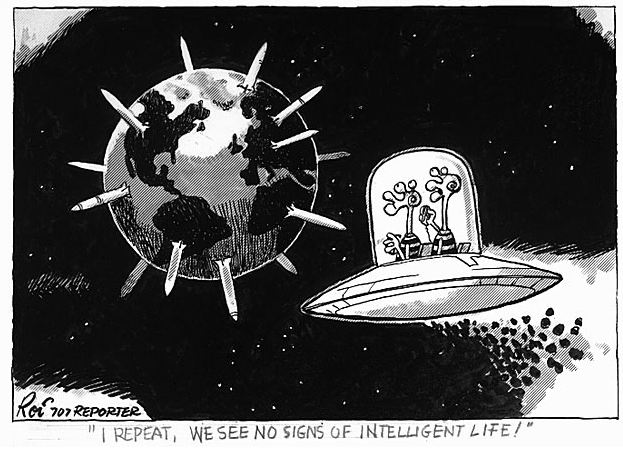
The Canadian archives website also features this cartoon:

reply to post by IsaacKoi
AMAZING stuff Mr Koi - just wanted to say thank-you, again, before I immerse myself in this latest treasure trove you have so kindly provided.
Maybe you should have call this thread:
"Tell your wife/husband/boss you are going to be busy reading UFO literature for the next week"
Now - on to the good stuff.......
##note to self - DO NOT accept debate offer on ATS if its about UFO's and Mr IssacKoi is the opponent##
AMAZING stuff Mr Koi - just wanted to say thank-you, again, before I immerse myself in this latest treasure trove you have so kindly provided.
Maybe you should have call this thread:
"Tell your wife/husband/boss you are going to be busy reading UFO literature for the next week"
Now - on to the good stuff.......
##note to self - DO NOT accept debate offer on ATS if its about UFO's and Mr IssacKoi is the opponent##
edit on 20-11-2012 by Sublimecraft because: (no reason given)
Thanks. I appreciate your massive effort. It woud presumably take a lot more to find the really juicy stuff in there.
12S&1F (and a place on my list of top ufologists)
12S&1F (and a place on my list of top ufologists)
Thank you for this thorough thread.
It will take a lot of time to sift trough all of this. But it will be fun.
Good work.
It will take a lot of time to sift trough all of this. But it will be fun.
Good work.
To hell with it, i decided ill just download the whole thing...thank you sir....!
Should have it all inside ole betsey here in another 42 minutes......
Much appreciated as i always have believed in the relative sanity and intelligence of WB Smith.
I would like to find out if there is anything in there about the "device " he constructed to extract power from the earths magnetic field......from what ive read it aparently worked well enough that he thought it would have practical value when scled up......any ideas about it ?? Warmest regards...s
Should have it all inside ole betsey here in another 42 minutes......
Much appreciated as i always have believed in the relative sanity and intelligence of WB Smith.
I would like to find out if there is anything in there about the "device " he constructed to extract power from the earths magnetic field......from what ive read it aparently worked well enough that he thought it would have practical value when scled up......any ideas about it ?? Warmest regards...s
new topics
-
Almost Home
Short Stories: 32 minutes ago -
Kamala finally builds a wall...around her home in DC
Jokes, Puns, & Pranks: 1 hours ago -
Ok Melbourne, Really?
Music: 3 hours ago -
Predictions for the result
2024 Elections: 6 hours ago
top topics
-
Predictions for the result
2024 Elections: 6 hours ago, 10 flags -
Both KAMALA and OBAMA are on the Nov 5th 2024 Ballot - If One Loses - Both Lose.
2024 Elections: 17 hours ago, 8 flags -
Kamala finally builds a wall...around her home in DC
Jokes, Puns, & Pranks: 1 hours ago, 2 flags -
Almost Home
Short Stories: 32 minutes ago, 2 flags -
Ok Melbourne, Really?
Music: 3 hours ago, 1 flags
active topics
-
Trump thinks Liz Cheaney should be shot in the face?
US Political Madness • 104 • : YourFaceAgain -
Mood Music Part VI
Music • 3686 • : BrucellaOrchitis -
Predictions for the result
2024 Elections • 67 • : WeMustCare -
Transgender woman accuses Hooters of sex-based discrimination for refusing to hire her
Rant • 19 • : YourFaceAgain -
-@TH3WH17ERABB17- -Q- ---TIME TO SHOW THE WORLD--- -Part- --44--
Dissecting Disinformation • 3097 • : Thoughtful3 -
British Man Jailed for over 2 Years for Shouting at Police During Protest has Died in Prison
Social Issues and Civil Unrest • 28 • : BrucellaOrchitis -
Betting markets have Trump by a good bit
2024 Elections • 175 • : SourGrapes -
The Acronym Game .. Pt.4
General Chit Chat • 892 • : Moon68 -
Stonehenge offers up a new Mystery - The Altar Stone
Ancient & Lost Civilizations • 43 • : BrucellaOrchitis -
Almost Home
Short Stories • 0 • : Moon68
